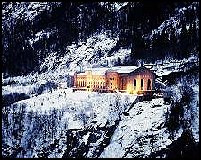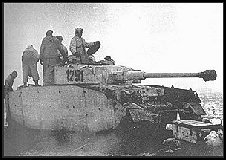 The Norsk Hydroelectric Plant near Telmark before the raid. |
Project 60: A Day-by-Day Diary of WWII
Remembering the First Fight Against Fascism |
 German PzKw IV prepares to go into action south of Kharkov |
 The Norsk Hydroelectric Plant near Telmark before the raid. |
Project 60: A Day-by-Day Diary of WWII
Remembering the First Fight Against Fascism |
 German PzKw IV prepares to go into action south of Kharkov |
Despite orders from Hitler himself to
hold the city to the last, General Hauser orders his 2nd SS Panzer Korps to abandon Kharkov as it is about to be
surrounded by elements of the Soviet 40th Army and 3rd
Tank Army. The Soviets enter the city during the day. In Tunisia, 5th Panzer
Army's advance past Kasserine Pass is temporarily suspended as elements of
Montgomery's 8th Army occupies Medenine on the approaches to the
Mareth line. The German offensive in Tunisia
continues as the American's continue to take huge losses in men and material.
1st Armored Division is particularly seriously hit, losing 2/3 of its
strength. Von Arnim redirects his forces against Foundouk while Rommel's
forces to the south enter Feeriana. Rommel, wanting a greater victory, had hoped
Von Arnim would head for Sbeitla, which would have destroyed an even greater
portion of the American force. This was to be only the first of many command
coordination problems for the Germans in Tunisia. Hitler, panicked over the constant
retreats of his armies in Russia, flies to Zaporozhye to harass Field Marshal
von Manstein for his failures. Von Manstein calmly lays out the plan for his
counter-attack on the already overextended Soviet spearheads. Hitler accepts the
plan. German attacks continue as the routed
American forces abandon Sbeitla. Rommel, von Arnim and the Italians still
can't decide on the direction for the continued offensive, giving the Allies
time to react. Attu Island is bombarded by an American
task force under Admiral McMorris (2 cruisers and 4 destroyers). Hans and Sophie Scholl were arrested in Munich. Their crime was painting anti-Hitler slogans on a wall in the town square and distributing anti-Nazi pamphlets. Their punishment was decapitation by guillotine. German U-boats begin attacks on convoy
ON-l16 in the North Atlantic. Before the two-day running battle was done, 14
merchants of 85,000 tons would be sunk at the cost of one U-boat. After days of arguing on objectives,
the German offensive in Tunisia resumes. A two pronged attack, lead by 15th
and 21st Panzer Divisions were to take Le Kef. However, Allied forces
had occupied the mountain passes the German tankers would have to move through. Hitler, hearing the thunder of Russian artillery and finding out that Soviet tanks are only 60 miles from Zaporozhye, hastily decides to cut short his visit to von Manstein's headquarters and return to the safety of his HQ at Vinnitsa. The German offensive in Tunisia meets heavy resistance from British tank forces, including the Guards Brigade, supported by heavy artillery fire from the Americans. The only success for the Germans comes at Kasserine Pass, where elements of 15th and 10th Panzer Divisions broke through only to be met by the British 26th Armored Brigade, limiting the advance to 10 miles. Heavy fighting takes place in Tunisia
as the German 10th Panzer Division batters against the British armor
at Thala while the regrouped US 1st Armored Division holds Tebessa
against attacks by 15th Panzer Division. Elements of the US 43rd Infantry
Division under General Hester occupy Banika and Pavuvu in the Russell Islands
after the Japanese abandoned the islands. British commandos raid Japanese bases at Akyab in Burma. February 22, 1943 Von Manstein launches his "Backhanded
Blow" against the overextended Soviet spearheads. The counteroffensive to
recapture Kharkov begins as elements of the German 1st and 4th Panzer Armies
strike from south to north from the area west of Krasnoarmeskoye while
reinforced elements of 2nd SS Panzer Corps attacks north to south from Krasnodar.
Meanwhile, oblivious to the threat to their flanks and rear, the Soviet
spearhead under Popov continues to advance west, deeper into the trap von
Manstein has sprung. Heavy fighting continued through the
night and early morning ours around Thala. Both sides took heavy losses before
the Germans withdrew in the afternoon. The Regiment Normandie took to
the air over Russia for the first time. This fighter unit was formed from
anti-Vichy French forces in Syria in 1942. The Bulgarian government agreed to
deport 11,000 Jews living in Yugoslavia and Greece. Within a month, all had been
captured and transported to Treblinka, where they were killed. Von Manstein's offensive rolls
forward as the German 48th Panzer Korps takes Barvenkovo. Meanwhile,
Soviet forces capture Sumy and Lebedin northeast of Kharkov. The newly formed 16th Rifle Division went into action for the first time on the Russian front. This formation was made up almost exclusively of Lithuanian Jews. Needless to say, they fought with uncommon vigor. After the failure of their offensive in Tunisa, the Axis forces decided on a unified command. Rommel is to command Army Group Afrika while von Arnim commands 5th Panzer Army and Messe commands the Italian 1st Army. Allied forces started their new
strategy of "round-the-clock bombing" as Americans hit Germany during the
daylight and RAF bombers at night. In the next two days, 2000 sorties would
strike German targets. Tensions between "allies" intensifies as the Polish Government in exile stated that it expected that the Soviet Union would restore Poland's pre‑war eastern frontier. This statement came in protest against the Russian decisions affecting Polish sovereignty over eastern territories and the rights of Polish citizens there. The Germans launch a limited attack against the British at Medjez el Bab in northern Tunisia with the 10th and 21st Panzer Divisions. No appreciable progress is made. Von Manstein's southern pincer continue
to gain ground, occupying a line from Lozovaya to Kramatorsk. Operation "Factory Action" commenced in Berlin as the last 8000 Jews in the city were rounded up for deportation. Most were factory workers, exempt from deportation up till now. Within 24 hours, these people were on their way to Auschwitz. A daring raid, Norwegian commandos launched attacks against The Norsk Hydro power station near Telemark in Norway. The site was the German "heavy water" atomic weapons research facility and it was destroyed in the attack. Te Red Army forces occupy Demyansk as the Germans withdraw from the salient. US aircraft spot and attack a Japanese
convoy carrying elements of General Nakano's 51st Division en route
to Lae from Rabaul. US forces in Tunisia follow the retreating Germans, occupying Sbeitla and advancing toward Feriana. Fighting continues in the north as von Arnim continues to probe at the British defenses. Red Army forces occupy Rzhev as the
Germans withdraw from the exposed postion. Soviet attacks north of Kharkov
continue to gain ground as Lgov, west of Kursk, is captured. The situation south
of Kharkov is not going well as the Papov finally realizes his mistake and
begins to withdraw. 9000 prisoners are taken in the first of many surrenders to
come in the next few weeks. Wingate's Chindits make their
presence know to the Japanese by blowing up several miles of the
Mandalay-Myitkyina railroad in Burma. Attacks continue on the Japanese convoy
carrying elements of the 51st Division in the Bismarck Sea. An air raid warning was sounded in London. It was a false alarm. Regretably, 173 civilians were killed a panicked crush attempting to enter the shelters at Bethnal Green. US PT-boats join in the air attacks on
the convoy carrying the Japanese 51st Division. After three days of
attacks, all 8 transports, carrying 7000 troops, along with 4 of the 8 escorting
destroyers are sunk. At least half of the infantry force is lost. In the air, 25
Japanese planes were shot down while the US-Australian force lost 5 planes. Montgomery reinforces his already
strong defenses around Medenine as elements of the 10th and 21st
Panzer Divisions head south. North of Kharkov, Red Army forces
continue to make advances against the Germans capturing Olenino and Chertolino
to the west of Rzhev, and Sevsk and Sudzha west of Kursk. However, von
Manstein's redirects his attacks at Kharkov sending the SS Panzer Corps west
from Poltava and elements of 4th Panzer Army attack northward from
positions along the Berestovaya River, west of Izyum. Japanese forces in Burma launch an attack against the British columns attempting to take Akyab. After a winter of limited raid,
"Bomber" Harris unleashes RAF Bomber Command in a major offensive against
Germany's industrial heartland in the Rhur. The first victim in the terror
bombing raids is Essen where 443 planes attacked. The use of the Oboe
targeting system greatly improved accuracy as 160 acres of the city were
devastated including 53 buildings in the Krupps works. Over 5000 homes were
destroyed and 475 civilians killed. Von Manstein's attack continues as elements of 4th Panzer Army mauls the retreating Soviet forces west of Izyum. However, the attack could not be forces over the Donets River as the ice on the river was breaking up preventing bridging operations. Red Army troops capture Gzhatsk,
between Vyazma and Rzhev. Rommel launches his attack on Medenine.
Montgomery's defenses defeat the attack. Rommel renewed the attack in the
afternoon and, once again, failed to make any headway against the thick
defenses. By the end of the day, Rommel had less than 100 tanks left. Wingate's Chindits continue blowing
up bridges and railroads in Burma. A US Navy force of three cruisers and
seven destroyers bombard Japanese airfields at Munda and Vila. In a chance
engagement, the force stumbles on two Japanese destroyers, which are. General George S. Patton takes command
of the beaten and poorly handled US II Corps in Tunisia after their drubbing at
Kassarine Pass. U-boats intercept convoy SC-121 in the north Atlantic. 13 merchants of the 56-ship convoy would be sunk Von Manstein redirects 4th Panzer Army westward and now attacks northeast from around Krasnograd in an attempt to link up with the SS Panzer Corps. March 8, 1943 As the jaws of von Manstien's pincer
attack begin to close on the Red Army forces outside Kharkov, Soviet troops take
Sychevka between Rzhev and Vyazma. In an attempt to improve communications
security, the German U-boats begin operating with a fourth rotor on their Enigma
equipment. This creates some problems for the Allies but the code breakers are
able to break the new system with minimal effort. Japanese forces in China cross the Yangtze River between Ichang and Yoyang. 1941 Archive: 1942 Archive: 1943 Archive: Special Editions: Editor's Corner Archive: Hitler's Angle "The story of Prescott Bush and his association with the Nazis begins just before the end of World War I..." The Past Through Tomorrow "It is quite frightening to realize just how similar our nation's actions have been and appear to be heading when compared this way..." Afghanistan and Vietnam: When the "war against terrorism" began, many knowledgeable people warned that our operations in Afghanistan would turn into another Vietnam. Want to Win - Think Before You Lash Out - "If we are serious about taking the war to the enemy, it is time to look ..." The First Fight Against Fascism - We must remember the Spanish Civil War also. Arguing Victory - "... Each nation who fought against fascist tyranny in WWII brought with it part of whole needed to defeat that evil..." War, Glory, Honor and Remembrance - "War is a brutal and savage insult on human society..." The First
Casualty... in time of war, those in power are even more inclined to
hide the truth, since that truth is often manifest in the most gruesome and
terrible acts. Those wishing to contribute items. stories or comments should contact D.A. Friedrichs |